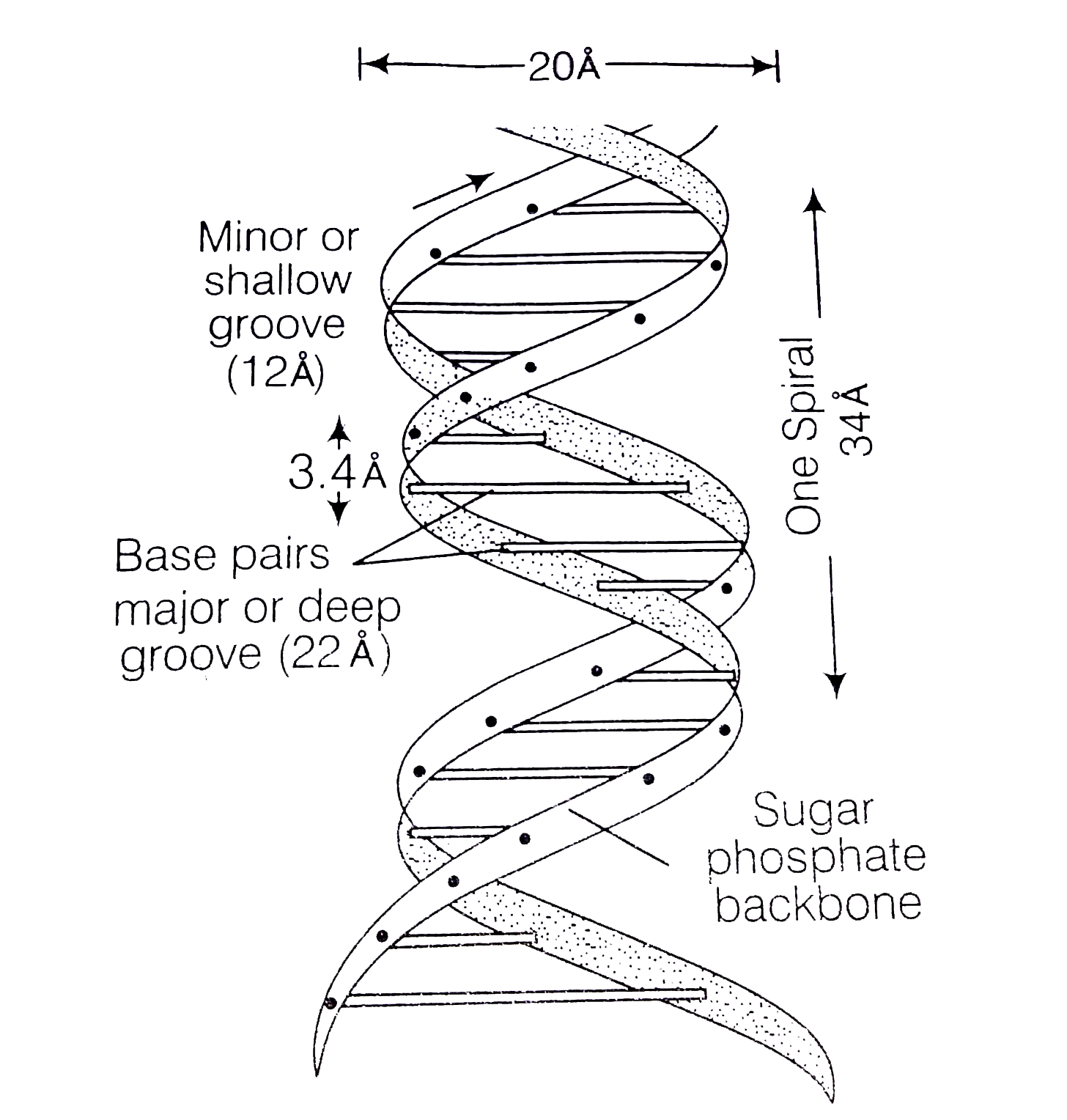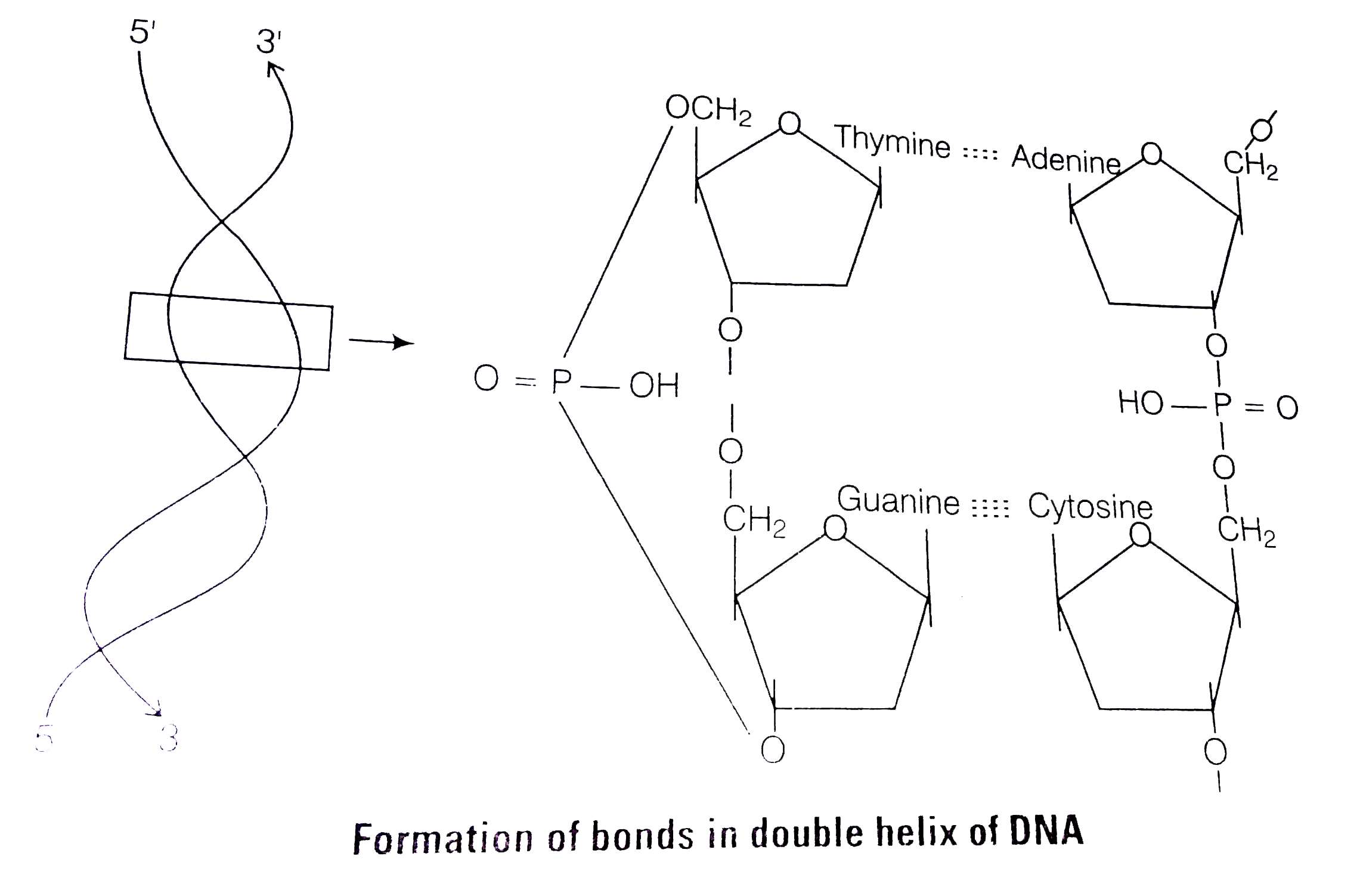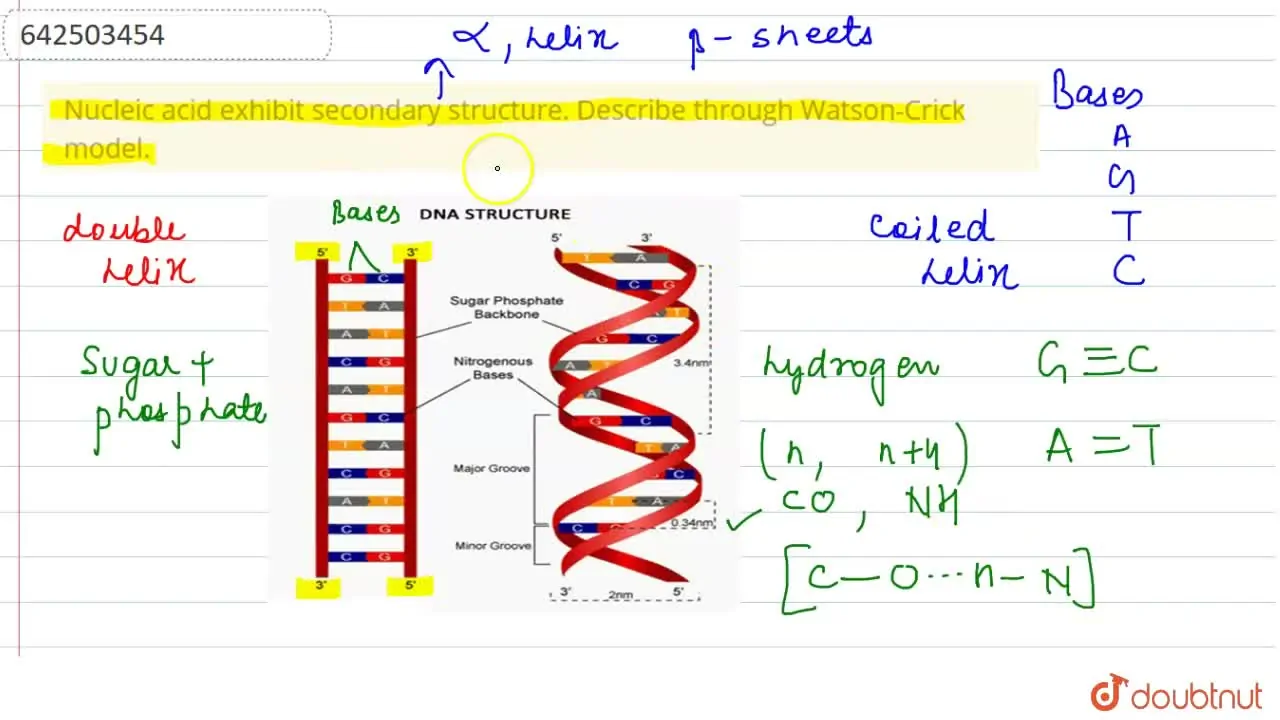Nucleic acid exhibit secondary structure. Describe through Watson-Crick model.
Nucleic acids are long chain macromolecules which are formed by end to end Ans. polymerisation of large number of repeated units called nucleotides. Nucleic acids show a wide range of secondary structures. A secondary structure is the set of InteractIons between bases and sugar phosphate backbone and is responsible for the shape that nucleic acid. 
James Watson and Francis Crick proposed a secondary structure of DNA molecules based on the crystallographic studies.
(i) DNA or deoxyribonucleic acid is a helically twisted double-chain polydeoxyribo- nucleotide macromolecule.
(ii) The two strands of DNA run anti-parallely to each other called as DNA duplex.
(iii) The spiral twisting of DNA has two types of alternate grooves, i.e., major and minor.
(iv) One turn of 360∘ of the spiral has about 10 nucleotides on each strand of DNA, occupying a distance of about 3.4 nm.
(v) The nucleotides within each strand are held together by the phosphodiester bonds between the 5' carbon of one nucleotide and the 3' carbon of the adjacent nucleotide. These strong covalent bonds holds the sugar/phosphate backbone together.
(vi) The two strands of DNA are held together by weak hydrogen bonds between the nitrogenous bases. These hydrogen bonds are base specific. That is adenine forms 2 hydrogen bonds with thymine CA= T and cytosine forms 3 hydrogen bonds with guanine (C≡G)
(vii) As specific and different nitrogen bases occur on two DNA chains, they are said to be complementary, i.e., purine lies opposite to pyrimidine. This purine-pyrimidine pairing also contributes to the thickness of strand, i.e., 2nm, and makes the two chains complementary

Related Playlists
- BOOK - NCERT EXEMPLAR ENGLISHCHAPTER - BIOMOLECULES EXERCISE - Short Answer Type Questions5videos
BIOMOLECULES
- BOOK - NCERT EXEMPLAR ENGLISHCHAPTER - BIOLOGICAL CLASSIFICATIONEXERCISE - Long answer5videos
BIOLOGICAL CLASSIFICATION
- BOOK - NCERT EXEMPLAR ENGLISHCHAPTER - Body Fluids and Circulation EXERCISE - LONG ANSWER TYPE Q5videos
Body Fluids and Circulation
Similar Questions
Nucleic acids exhibit secondary structure, justify with example.
View SolutionA peptide chain attains secondary structure through the formation of
View SolutionDefine nucleic acid. Describe the structure of DNA model proposed by Watson and Crick.
View SolutionClover leaf model of holley for tRNA is a 2D model giving secondary structure. A 3D model showing tertiary structure was
View SolutionAssertion : All proteinaceous enzymes have a three dimensional structure
Reason : The secondary structure of protein is according to amino
acids present inside the polypeptideView SolutionWhile proposing double helical structure for DNA, Watson and Crick proposed scheme for
View SolutionWhat are the functions of nucleic acids ? What are the structures of sugar molecules present in DNA and RNA.
View SolutionIn α− helix secondary structure, hydrogen bonds lie between oxygen of carboxylic group of first amino acid to the -NH group of the
View SolutionThe chemical formula of deoxyribonucleic acid
(DNA) is now well established. The molecule is a
very long chain, the backbone of which consists of a
regular alternation of sugar and phosphate groups.
5 To each sugar is attached a nitrogenous base, which
can be of four different types. Two of the possible
bases—adenine and guanine—are purines, and the
other two—thymine and cytosine—are pyrimidines.
So far as is known, the sequence of bases along the
10 chain is irregular. The monomer unit, consisting of
phosphate, sugar and base, is known as a nucleotide.
The first feature of our structure which is of
biological interest is that it consists not of one chain,
but of two. These two chains are both coiled around
15 a common fiber axis. It has often been assumed that
since there was only one chain in the chemical
formula there would only be one in the structural
unit. However, the density, taken with the X-ray
evidence, suggests very strongly that there are two.
20. The other biologically important feature is the
manner in which the two chains are held together.
This is done by hydrogen bonds between the bases.
The bases are joined together in pairs, a single base
from one chain being hydrogen-bonded to a single
25 base from the other. The important point is that only
certain pairs of bases will fit into the structure.
One member of a pair must be a purine and the other
a pyrimidine in order to bridge between the two
chains. If a pair consisted of two purines, for
30 example, there would not be room for it.
We believe that the bases will be present almost
entirely in their most probable forms. If this is true,
the conditions for forming hydrogen bonds are more
restrictive, and the only pairs of bases possible are:
35 adenine with thymine, and guanine with cytosine.
Adenine, for example, can occur on either chain, but
when it does, its partner on the other chain must
always be thymine.
The phosphate-sugar backbone of our model is
40 completely regular, but any sequence of the pairs of
bases can fit into the structure. It follows that in a
long molecule many different permutations are
possible, and it therefore seems likely that the precise
sequence of bases is the code which carries the
45 genetical information. If the actual order of the bases
on one of the pair of chains were given, one could
write down the exact order of the bases on the other
one, because of the specific pairing. Thus one chain
is, as it were, the complement of the other, and it is
50 this feature which suggests how the deoxyribonucleic
acid molecule might duplicate itself.
The table shows, for various organisms, the percentage of
each of the four types of nitrogenous bases in that
organism’s DNA.

Adapted from Manju Bansal, “DNA Structure: Revisiting the
Watson-Crick Double Helix.” ©2003 by Current Science Association,
Bangalore
31. Based on the table, is the percentage of adenine in each organism’s DNA the same or does it vary, and which statement made by the authors is most consistent with that data?View SolutionThe chemical formula of deoxyribonucleic acid
(DNA) is now well established. The molecule is a
very long chain, the backbone of which consists of a
regular alternation of sugar and phosphate groups.
5 To each sugar is attached a nitrogenous base, which
can be of four different types. Two of the possible
bases—adenine and guanine—are purines, and the
other two—thymine and cytosine—are pyrimidines.
So far as is known, the sequence of bases along the
10 chain is irregular. The monomer unit, consisting of
phosphate, sugar and base, is known as a nucleotide.
The first feature of our structure which is of
biological interest is that it consists not of one chain,
but of two. These two chains are both coiled around
15 a common fiber axis. It has often been assumed that
since there was only one chain in the chemical
formula there would only be one in the structural
unit. However, the density, taken with the X-ray
evidence, suggests very strongly that there are two.
20. The other biologically important feature is the
manner in which the two chains are held together.
This is done by hydrogen bonds between the bases.
The bases are joined together in pairs, a single base
from one chain being hydrogen-bonded to a single
25 base from the other. The important point is that only
certain pairs of bases will fit into the structure.
One member of a pair must be a purine and the other
a pyrimidine in order to bridge between the two
chains. If a pair consisted of two purines, for
30 example, there would not be room for it.
We believe that the bases will be present almost
entirely in their most probable forms. If this is true,
the conditions for forming hydrogen bonds are more
restrictive, and the only pairs of bases possible are:
35 adenine with thymine, and guanine with cytosine.
Adenine, for example, can occur on either chain, but
when it does, its partner on the other chain must
always be thymine.
The phosphate-sugar backbone of our model is
40 completely regular, but any sequence of the pairs of
bases can fit into the structure. It follows that in a
long molecule many different permutations are
possible, and it therefore seems likely that the precise
sequence of bases is the code which carries the
45 genetical information. If the actual order of the bases
on one of the pair of chains were given, one could
write down the exact order of the bases on the other
one, because of the specific pairing. Thus one chain
is, as it were, the complement of the other, and it is
50 this feature which suggests how the deoxyribonucleic
acid molecule might duplicate itself.
The table shows, for various organisms, the percentage of
each of the four types of nitrogenous bases in that
organism’s DNA.

Adapted from Manju Bansal, “DNA Structure: Revisiting the
Watson-Crick Double Helix.” ©2003 by Current Science Association,
Bangalore
25. The authors’ main purpose of including the information about X-ray evidence and density is toView Solution


